Beth Groundwater's Blog, page 27
October 12, 2012
Summit County Library Event
Tonight from 7 - 9 PM, I will appear at the "Colorado Author Night" at the main Frisco, CO branch of my local library, the Summit County Library in Summit County, CO. I count two of the other three authors (Mark Stevens, Paula Scanland, and Greg Hill) as friends, so I hope those of you who are within driving distance will come to the program. The address of the Frisco branch is County Commons Building, 0037 County Road 1005, Frisco, CO 80443.
Published on October 12, 2012 04:00
October 11, 2012
Photos from Bouchercon 2012
I had a great time at the 2012 Bouchercon mystery conference in Cleveland, Ohio last weekend. Named after mystery author Anthony Boucher, this is the largest annual mystery convention in the United States, where mystery authors and their fans can mix and meet. I've heard estimates ranging from 1200 to 1700 for the number of attendees last weekend.
I arrived in Cleveland on Thursday after leaving home at 5 AM, just in time for the evening Opening Ceremonies at the Rock and Roll Hall of Fame. The photo below is of me posing by one of the giant guitars that decorated the plaza in front of the museum.

Friday morning was the Sisters in Crime breakfast, business meeting and Parnell Hall sing-along (look for me in his video once he posts it). I was thrilled to sit next to Doris Ann Norris (see photo below), known as the 2000 year old librarian and honored as the Bouchercon Fan Guest of Honor. Doris is why I really wanted to come to this conference, to join in honoring this dear lady.
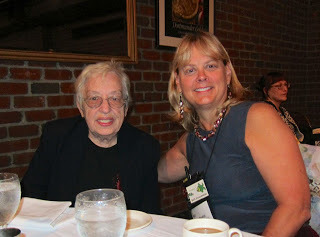
After a busy morning of panels and chatting with people in the hallways, the Hospitality Suite, and the Book Room, I gathered with Terri Bischoff, the Midnight Ink Acquisition Editor, and other attending Midnight Ink authors for lunch. See the group photo below (I'm waaay down on the end).
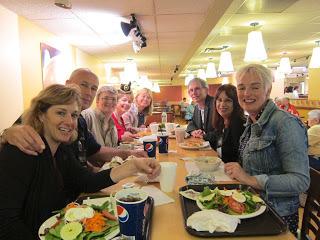
I volunteered to man the registration desk Friday afternoon and was able to sign in the Midnight Ink Publicity Director, Steven Pomije, who arrived just as we were closing the desk. He'd been held up at the airport because it was locked down for an hour while President Obama left after giving a speech in Cleveland. I showed Steven around, then we rendezvoused with Terri and others for drinks before going to the evening reception.
After a fun-filled morning of panels on Saturday, I took photos of the Midnight Ink signing at the Mystery Mike's booth in the Book Room late morning, where authors Colin Campbell (first on the left), Darrell James (second on the right) and Maggie Sefton (first on the right) signed copies of their books (or ARCs, in Colin's case). The first photo below shows them with Terri and Steven (in the middle). The second photo shows the shelf of Midnight Ink titles (including mine) at the Loganberry Books booth in the Book Room.
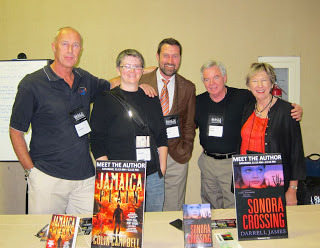
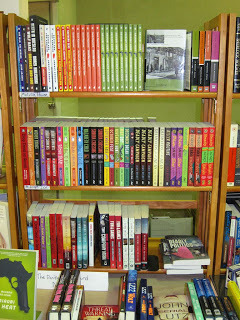
Next on my fun-time agenda was lunch with the Sisters in Crime Guppies on-line chapter, where I chatted with fellow members, some of whom I'd only known on-line in the past. Now I can put names to faces! Unfortunately, I was too busy chatting to get photos. I hope some others there took some. More panels and Guest of Honor interviews followed, then the Raffle Auction drawing. At the drawing, I volunteered to be a runner, delivering prizes to those who won them. The conference committee awarded me a very cool bright yellow Crime Scene Tape scarf for my volunteer work, which I will wear often and treasure.
After the prizes were all given out, the Anthony Awards were announced, and I was pleased to see so many women being honored, some of whom I count as friends. I've got Sara J. Henry's Best First Novel, Learning to Swim, on my to-read pile. I ended up the evening at The Chocolate Bar restaurant, enjoying a dark chocolate chili martini and Belgian chocolate pyramid dessert (see photo below). Yum!
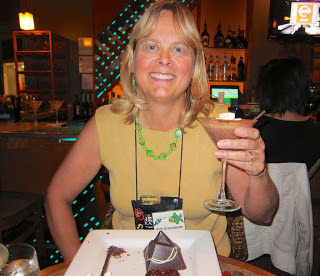
Sunday morning, my roommate, fellow mystery author Karen Pullen, and I checked out of the hotel and stashed our bags. Then it was finally my turn to be on a panel, "Red Herrings" with Keith Raffel (moderator), Ross Pennie, Diane Pirone-Gelman, and Janice Hamrick. The last two photos below show the whole panel and me up close. Keith was extremely funny and made it a good time for all involved. After signing books, one last panel, and lunch, Karen and I were off to the train station and the airport. I didn't get home until midnight that night!
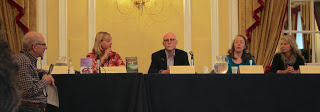
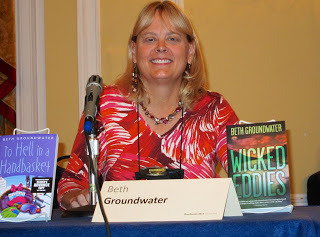

I arrived in Cleveland on Thursday after leaving home at 5 AM, just in time for the evening Opening Ceremonies at the Rock and Roll Hall of Fame. The photo below is of me posing by one of the giant guitars that decorated the plaza in front of the museum.

Friday morning was the Sisters in Crime breakfast, business meeting and Parnell Hall sing-along (look for me in his video once he posts it). I was thrilled to sit next to Doris Ann Norris (see photo below), known as the 2000 year old librarian and honored as the Bouchercon Fan Guest of Honor. Doris is why I really wanted to come to this conference, to join in honoring this dear lady.

After a busy morning of panels and chatting with people in the hallways, the Hospitality Suite, and the Book Room, I gathered with Terri Bischoff, the Midnight Ink Acquisition Editor, and other attending Midnight Ink authors for lunch. See the group photo below (I'm waaay down on the end).

I volunteered to man the registration desk Friday afternoon and was able to sign in the Midnight Ink Publicity Director, Steven Pomije, who arrived just as we were closing the desk. He'd been held up at the airport because it was locked down for an hour while President Obama left after giving a speech in Cleveland. I showed Steven around, then we rendezvoused with Terri and others for drinks before going to the evening reception.
After a fun-filled morning of panels on Saturday, I took photos of the Midnight Ink signing at the Mystery Mike's booth in the Book Room late morning, where authors Colin Campbell (first on the left), Darrell James (second on the right) and Maggie Sefton (first on the right) signed copies of their books (or ARCs, in Colin's case). The first photo below shows them with Terri and Steven (in the middle). The second photo shows the shelf of Midnight Ink titles (including mine) at the Loganberry Books booth in the Book Room.


Next on my fun-time agenda was lunch with the Sisters in Crime Guppies on-line chapter, where I chatted with fellow members, some of whom I'd only known on-line in the past. Now I can put names to faces! Unfortunately, I was too busy chatting to get photos. I hope some others there took some. More panels and Guest of Honor interviews followed, then the Raffle Auction drawing. At the drawing, I volunteered to be a runner, delivering prizes to those who won them. The conference committee awarded me a very cool bright yellow Crime Scene Tape scarf for my volunteer work, which I will wear often and treasure.
After the prizes were all given out, the Anthony Awards were announced, and I was pleased to see so many women being honored, some of whom I count as friends. I've got Sara J. Henry's Best First Novel, Learning to Swim, on my to-read pile. I ended up the evening at The Chocolate Bar restaurant, enjoying a dark chocolate chili martini and Belgian chocolate pyramid dessert (see photo below). Yum!

Sunday morning, my roommate, fellow mystery author Karen Pullen, and I checked out of the hotel and stashed our bags. Then it was finally my turn to be on a panel, "Red Herrings" with Keith Raffel (moderator), Ross Pennie, Diane Pirone-Gelman, and Janice Hamrick. The last two photos below show the whole panel and me up close. Keith was extremely funny and made it a good time for all involved. After signing books, one last panel, and lunch, Karen and I were off to the train station and the airport. I didn't get home until midnight that night!


Published on October 11, 2012 04:00
October 9, 2012
Today's Mystery Author Guest: Susan M. Boyer
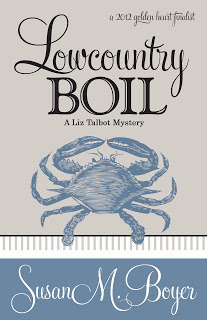
As promised yesterday, fellow mystery author Susan M. Boyer is visiting my blog today. To read her bio and see her photo, please page down to yesterday's post.
The photo above is the cover for her September 18th release, Lowcountry Boil , which begins her new series with Private Investigator Liz Talbot. Private Investigator Liz Talbot is a modern Southern belle: she blesses hearts and takes names. She carries her Sig 9 in her Kate Spade handbag, and her golden retriever, Rhett, rides shotgun in her hybrid Escape. When her grandmother is murdered, Liz high-tails it back to her South Carolina island home to find the killer. She’s fit to be tied when her police-chief brother shuts her out of the investigation, so she opens her own. Then her long-dead best friend pops in and things really get complicated. When more folks start turning up dead in this small seaside town, Liz must use more than just her wits and charm to keep her family safe, chase down clues from the hereafter, and catch a psychopath before he catches her.
Below are Susan's answers to my interview questions. Please leave a comment for her, and if you have a question of your own for her, ask it!
1. Who or what inspired you to start writing and when did you start?
First of all, thank you so much, Beth, for having me today. I love your RM Outdoor Adventure series, and I’m thrilled to be a guest on your blog!
I’ve had a life-long love affair with books. I loved reading them so much, I think I’ve always wanted to write my own. I’ve fiddled with writing off and on forever. But, there were children to raise and bills to pay. I started seriously writing in 2004, when the company I had worked for went out of business.
2. What tools and process do you use to “get to know” your characters before and while you’re writing the books?
I do a character sketch, then start asking them questions. They typically answer. I used to cut out pictures from magazines and tape them to poster board. I now use online tools for visuals.
3. How do you construct your plots? Do you outline or do you write “by the seat of your pants”?
I start with a very basic outline, then begin writing. Sometimes I end up changing the outline as I go along. I’m a hybrid model—a plotter with pantser tendencies.
4. In the age-old question of character versus plot, which one do you think is most important in a murder mystery and which one do you emphasize in your writing? Why?
I know this sounds like a wimpy cop-out, but I think both are equally important. Strong characters reacting to an interesting situation gives you a strong plot. It’s almost like a chicken and egg thing to me. I’m not sure you can have one without the other.
5. What is the biggest challenge you’ve faced as a writer and what inspires you and keeps you motivated?
I have a tendency go off on tangents—to say yes to things that, while important, beneficial, and fun, ultimately steal my writing time. Like the two years I was conference chairperson for the South Carolina Writers’ Workshop conference. That was an awesome experience, but I didn’t get much writing done during those two years. What keeps me motivated? I love what I do.
6. What is a typical workday for you and how many hours a day (or week) do you devote to writing?
Most days I’ve had breakfast and am at the computer with my second cup of coffee by 9:00 AM. I check email, because I seem to be incapable of just saying no. If I don’t, I worry while I try to write that there’s something in my inbox I need to address. After email, I pop into and quickly out of Facebook and Twitter. Then it’s words on the page. Some days I forget to stop and eat lunch, but if I do, I pay for it with a headache. When I stop for lunch, I plug back in to social networking, but don’t stay long. If I’m at home alone, some nights I’ll work until my stomach growls at 8 PM because I haven’t had dinner. I try to make myself quit at 5 PM and go to Jazzercise class. If I’m not at home (which is more often than not), I stop working when my husband gets back to the hotel and we exercise and then have dinner. I typically take the weekends off.
7. What advice do you have to offer to an aspiring author?
Oh, wow. I don’t think I’m qualified to offer advice. I’m still figuring all of this out myself. I guess if I had one thing to offer, and it’s not original by any means, it would be write on a schedule.
8. Now here’s a zinger. Tell us something about yourself that you have not revealed in another interview yet. Something as simple as your favorite TV show or food will do.
One of my favorite TV shows is Rizzoli and Isles. I love the banter between Jane and Maura.
9. What are you working on now and what are your future writing plans?
Right now I’m working on the next book in the Liz Talbot series. When I have a few more of her books out, I have another series in mind. But I think I’ll always be writing series characters, because I love to read them.
10. Is there anything else you would like to tell my blog readers?
I love to hear from readers! Please come visit me when you can on my website, or shoot me an email at susan@susanmboyerbooks.com . I hang out at the usual places: Facebook, Twitter, Pinterest, and Goodreads.
Thanks, Susan! Now, who has a comment or question for her?
Published on October 09, 2012 04:00
October 8, 2012
Tomorrow's Guest: Susan M. Boyer

Tomorrow, mystery author Susan M. Boyer will be a guest on my blog. Susan has been making up stories her whole life. She tags along with her husband on business trips whenever she can because hotels are great places to write: fresh coffee all day and cookies at 4 p.m. They have a home in Greenville, SC, which they occasionally visit. Susan’s short fiction has appeared in moonShine Review, Spinetingler Magazine, Relief Journal, The Petigru Review, and Catfish Stew. Her debut novel, Lowcountry Boil , is a 2012 RWA (Romance Writers of America) Golden Heart® finalist and a 2012 Daphne du Maurier finalist.
In her guest post tomorrow, Susan answers my interview questions, and I'm sure you'll be intrigued by what she has to say. Then, feel free to ask her some questions of your own in the comments.
Published on October 08, 2012 04:00
October 4, 2012
Room to Read
While I'm busy hobnobbing with fellow mystery authors and readers at Bouchercon, I wanted to draw your attention to a worthy international literacy charity that I recently found out about.
Room to Read works with communities and local governments in Asia and Africa to develop literacy skills and a habit of reading among primary school children. The charity's goals are establishing school libraries, building schools, publishing local language children's books, training teachers on literacy education and supporting girls to complete secondary school. They currently work in underdeveloped areas of Bangladesh, Cambodia, India, Laos, Nepal, South Africa, Sri Lanka, Vietnam and Zambia, but they hope to expand to other areas.
I hope you'll consider including Room to Read in your charity giving plans!
Room to Read works with communities and local governments in Asia and Africa to develop literacy skills and a habit of reading among primary school children. The charity's goals are establishing school libraries, building schools, publishing local language children's books, training teachers on literacy education and supporting girls to complete secondary school. They currently work in underdeveloped areas of Bangladesh, Cambodia, India, Laos, Nepal, South Africa, Sri Lanka, Vietnam and Zambia, but they hope to expand to other areas.
I hope you'll consider including Room to Read in your charity giving plans!
Published on October 04, 2012 04:00
October 2, 2012
Bouchercon Bound
Early Thursday morning I will step onto a plane bound for Cleveland, Ohio, and the Bouchercon mystery conference. Named after mystery author Anthony Boucher, this is the largest annual mystery convention in the United States, where mystery authors and their fans can mix and meet. Bouchercon will run from Thursday through Sunday. If you are attending, I hope you will find me at one of the following events, nab me and say hi!
6:30 – 9:00 PM on Thursday, Opening Ceremonies at the Rock and Roll Hall of Fame
7:30 – 8:45 AM on Friday, New Author Coffee Hour, Grand Ballroom A
6:00 – 8:00 PM on Friday, Auction and Reception
7:30 - 8:45 AM on Saturday, Sisters in Crime Breakfast, Shuckers Room
6:30 – 9:00 PM on Saturday, Anthony Awards Ceremony/Reception
9:00 – 9:50 AM on Sunday, "Red Herrings" panel with Keith Raffel (moderator), Ross Pennie, Diane Pirone-Gelman, Janice Hamrick, Melodie Campbell, and me, Ambassador Room
This will be followed by a signing period in the Book Room. I hope you'll stop by my table to chat.
6:30 – 9:00 PM on Thursday, Opening Ceremonies at the Rock and Roll Hall of Fame
7:30 – 8:45 AM on Friday, New Author Coffee Hour, Grand Ballroom A
6:00 – 8:00 PM on Friday, Auction and Reception
7:30 - 8:45 AM on Saturday, Sisters in Crime Breakfast, Shuckers Room
6:30 – 9:00 PM on Saturday, Anthony Awards Ceremony/Reception
9:00 – 9:50 AM on Sunday, "Red Herrings" panel with Keith Raffel (moderator), Ross Pennie, Diane Pirone-Gelman, Janice Hamrick, Melodie Campbell, and me, Ambassador Room
This will be followed by a signing period in the Book Room. I hope you'll stop by my table to chat.
Published on October 02, 2012 04:00
September 26, 2012
Dialogue Lessons: The Big Picture, Part 7
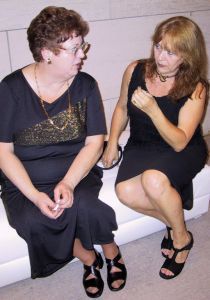
Today concludes my three-week series of posts on "The Art of Writing Dialogue." I'll list the last two of the ten "rules of thumb" I include under The Big Picture section and give you a set of resources to use. I'd love to get some feedback from my blog readers, too, on whether or not you found this series of lessons to be useful and interesting or not, and if you have any suggestions for me. If you liked the series, I may present more lessons in the future from other writing workshops I've given. On to the Big Picture!
9. Function and Pacing: Dialogue has many functions other than the basic ones of conveying information to the reader and moving the plot forward. It can create tension and suspense, and it controls pace by speeding up or slowing down scenes. It should be very quick in action scenes.
Bad:
“He’s got a gun! Shoot him! Shoot him!” Tina shouted.
“Get behind me. I’ll get him before he gets us.” Sweating profusely, Dave shoved her behind him. He yanked his gun out of his leg holster. He dropped it. “Shit, I dropped it.”
“Pick it up, you clumsy idiot, or he’ll shoot first and we’ll both die.”
Good:
“He’s got a gun!” Tina shouted.
Sweating profusely, Dave shoved her behind him. He yanked his gun out of leg holster. He dropped it. “Shit.”
“We’re gonna die.”
Dialogue develops characters and exposes motives, reveals setting (when they talk about the weather and the environs around them), establishes the scene’s mood, sprinkles in backstory and background information just where it’s needed rather than in big dumps at the beginning of the novel, and most importantly, intensifies conflict. Every piece of dialogue in your novel should accomplish as many of these goals as possible. Make every conversation work for you, and work hard, to earn the right to be included in the final manuscript.
10. Editing Prompts: Some helpful questions to ask while editing a section of dialogue:
Did my characters say exactly what they meant and exactly what I needed them to say?
Is each character’s dialogue in their unique voice?
Is each line of dialogue essential to the scene?
Does the dialogue move the plot forward?
Does the dialogue start a conflict or complicate an existing conflict?
Does the dialogue establish or increase the reader’s intimacy with the characters, and the characters’ with each other?
Does the dialogue convey emotion and is the emotion appropriate to the scene?
Is the body language of the characters attuned to what’s being said?
Most importantly, when I read it, am I bored or interested?
References:
Beginnings, Middles and Ends (Elements of Fiction Writing), Nancy Kress
Writing Dialogue, Tom Chiarella
Write Great Fiction – Dialogue, Gloria Kempton
Speaking of Dialogue, Sammie L. Justesen
William Shunn’s “Proper Manuscript Formatting” website: http://www.shunn.net/format/
Published on September 26, 2012 04:00
September 24, 2012
Dialogue Lessons: The Big Picture, Part 6

During September I'll be sharing some notes here on my blog from my "The Art of Writing Dialogue" workshop that I've presented to many writing groups. I presented the first three lessons on Mechanics, the nitty gritty little details of writing dialogue, week before last. Last week and this week I'm discussing The Big Picture, using character traits, conflict, and emotion to infuse a real-life feel into dialogue, to make it pop off the page. The goal is to drag readers by the throat right into the book. Here are the sixth, seventh and eighth of ten "rules of thumb" for The Big Picture. Come back next week for the last two and some recommended resources!
6. Business: Make the facial expressions, actions and gestures of the characters during a dialogue work for you. Set a goal to minimize the need for simple dialogue tags by replacing them with business that illuminates character traits, reveals conflict and describes emotion. An interesting way to flavor a dialogue is to make the unspoken thoughts and emotions the opposite of what’s being said.
Always give your characters something interesting to do or think about while they’re having a conversation. And that ‘something interesting’ should have emotion and conflict tied to it. For instance, instead of just eating a meal together, have one character serve the other a dish she hates. She knows that her friend knows she hates that food, so she wonders through the whole meal why he served to her and just pretends to eat it.
7. Conflict: Every piece of dialogue in your story should contain conflict of some sort. The conflict can be external and obvious in the speech and actions of the characters (they disagree about something, they’re working together to solve a problem or escape a danger, etc.). Or it can be internal, embedded in the emotional subtext (he's lying to her, she doesn't like him). But it has to be there. Dialogue illuminates character, but only if you give your characters something interesting to talk about, and that means conflict.
8. Emotion: Every piece of dialogue needs to be infused with emotion. Show that emotion by using facial expressions and gestures as well as speech to expose what the characters are feeling versus just tagging the speech verbs with adverbs. Get to know your characters well enough that you can visualize what they look like and what they’re doing while engaged in conversations.
Here’s an example from the first book in my RM Outdoor Adventures series, Deadly Currents , with the business revealing character, conflict and emotion removed. Just the dialogue and basic description of actions are left. See how flat it reads.
The two of them watched the coroner, her assistant, and two Sheriff’s deputies carry the body up to the roadbed.
Gonzo swept aside a chunk of hair the wind had blown into his face. “Bummer.”
Mandy nodded.
“Hey, it’s not your fault. If anything, it’s my fault.”
“No, Gonzo. He was alive when he left your care. He died under mine.”
A shadow fell over her. She looked up and saw Steve Hadley.
He knelt. “Mandy, a death is hard for any of us. It was an accident, pure and simple. You could do no more than follow your training. If that wasn’t enough, then it was meant to be.”
Mandy nodded again.
“Hey man,” Gonzo said to Steve. “Thanks for handling the wife. After Dougie walked his passengers downstream to the road, and the wife saw the EMTs working on her husband and screamed, Dougie looked at me like, hey buddy, you’re in charge of this trip, so this is your scene. But I had no frigging idea what to do.”
“Who does?” Steve said. “You just deal with it the best you can.”
“I’d rather have a Boy Scout blowing chunks right on my Tevas than have to comfort some lady who’s gone all hysterical. At least I knew his son, Jeff, some. Though I couldn’t do much more than say I was really sorry, dude.”
“Yeah, thanks, Steve.” Mandy said. “I probably should have said something to her. I know that’s the worst part of the job, when someone...”
Here’s the whole passage, with the business revealing character, conflict and emotion put back in (see the italics). Can you better see both the internal conflict (Mandy’s guilt that a man she tried to save ended up dying) and external conflict (she and Gonzo argue about whose fault it is). Do you feel more of what Mandy’s feeling? And what the non-POV characters, Gonzo and Steve, are feeling?
The two of them silently watched the coroner, her assistant, and two Sheriff’s deputies carry the body up to the roadbed.
Gonzo swept aside a chunk of bushy dark blond Rastafarian dreadlocks the wind had blown into his somber, sunburned face. “Bummer.”
Mandy nodded. Bummer indeed.
He shot a worried gaze her way. “Hey, it’s not your fault.”
He picked up a pebble and half-heartedly tossed it aside. “If anything, it’s my fault.”
“No, Gonzo. He was alive when he left your care. He died under mine.”
A shadow fell over her. She looked up and saw Steve Hadley, his well-muscled frame backlit by the sun.
He must have seen the devastation she felt in her face, because his expression softened. He knelt and put his hand on her knee. “Mandy, a death is hard for any of us. It was an accident, pure and simple. You could do no more than follow your training. If that wasn’t enough, then it was meant to be.”
Mandy worried her lip. Did she? Did she follow her training? Should she have done something different? Something better? Her throat constricted. Rather than expose her emotion by croaking out a response, she just nodded again.
“Hey man,” Gonzo said to Steve. “Thanks for handling the wife. After Dougie walked his passengers downstream to the road, and the wife saw the EMTs working on her husband and screamed, Dougie looked at me like, hey buddy, you’re in charge of this trip, so this is your scene. But I had no frigging idea what to do.”
“Who does?” Steve said. “You just deal with it the best you can.”
“I’d rather have a Boy Scout blowing chunks right on my Tevas than have to comfort some lady who’s gone all hysterical. At least I knew his son, Jeff, some. Though I couldn’t do much more than say I was really sorry, dude.”
Mandy gulped down the knot in her throat. “Yeah, thanks, Steve. I probably should have said something to her. I know that’s the worst part of the job, when someone...” She couldn’t say dies, not yet. And the thought of trying to console that poor woman while Mandy struggled with her own resurrected grief had frightened her to the core.
Notice how the word "silently" conveys a hint of reverence? Also notice how I inserted some description of Gonzo's hair and skin and Steve’s muscles. Gonzo’s worried glance and the pause while he tosses the pebble show he cares about Mandy but expressing that is awkward for him. Steve’s softened expression and his hand on her knee show his concern. Mandy’s thoughts, the knot in her throat, and the question left in the reader’s mind at the end about her resurrected grief reveal more of her character.
Some other things to note that tie back to previous lessons are: Gonzo’s unique speech patterns (bummer, this is your scene, no frigging idea, blowing chunks), Steve more formal language that shows he's the boss (follow your training), the whitewater rafting-specific terms (downstream, Tevas). And lastly, did you notice how many dialogue tags are in that long passage of dialogue? Because of the business that worked hard for me, I only used "said" twice.
Published on September 24, 2012 04:00
September 21, 2012
Dialogue Lessons: The Big Picture, Part 5
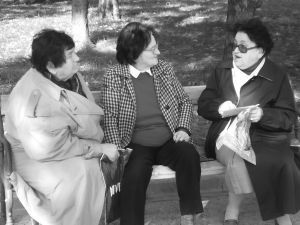
During September I'll be sharing some notes here on my blog from my "The Art of Writing Dialogue" workshop that I've presented to many writing groups. I presented the first three lessons on Mechanics, the nitty gritty little details of writing dialogue, last week. This week and next, I'm discussing The Big Picture, using character traits, conflict, and emotion to infuse a real-life feel into dialogue, to make it pop off the page. The goal is to drag readers by the throat right into the book. Here are the fourth and fifth of ten "rules of thumb" for The Big Picture:
4. Avoid long passages of foreign language, and for short passages, use context to explain them. If a dialogue is supposed to take place in a foreign language, you can preface it with something like, “Roger conversed with Hilda in perfect Swedish,” then write the dialogue in English. If a foreign phrase is important, such as it being a clue in an ancient cipher, have one character translate it to another who doesn’t understand the language, just like the reader.
Bad:
Jorge looked around. “¿Dónde está el baño?”
“Vuelta de la esquina,” Nancy answered.
Good:
Jorge asked in Spanish where the bathroom was, and Nancy answered in Spanish, “Around the corner.”
Or:
Jorge looked around. “¿Dónde está el baño?”
“The bathroom is around the corner,” Nancy answered in Spanish.
Then continue the conversation in English, allowing the reader to assume the characters continued to speak in Spanish.
5. Dialogue in fiction should sound like real conversations but have a much higher level of content than normal conversations. It should also be precise, with the meaning as clear as possible. It should always move the story forward in some way. Summarize the salt and pepper dialogue in narrative so you can get directly to the good stuff—emotion and conflict.
Bad:
“Hello, Sally, how are you?”
“Okay, I guess, and you?”
“I’m fine,” Mary replied. “But why’d you just say you were okay. Is something wrong?”
Sally wrung her hands. “My cat is missing.”
“Oh dear, for how long?”
Good:
After greeting Mary, Sally wrung her hands and said that her cat was missing.
“Oh dear, for how long?”
Published on September 21, 2012 04:00
September 19, 2012
Dialogue Lessons: The Big Picture, Part 4
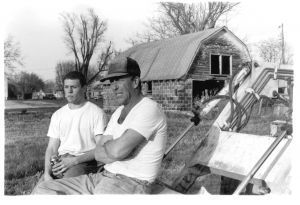 During September I'll be sharing some notes here on my blog from my "The Art of Writing Dialogue" workshop that I've presented to many writing groups. I presented the first three lessons on Mechanics, the nitty gritty little details of writing dialogue, last week. This week and next, I'll go into The Big Picture, using character traits, conflict, and emotion to infuse a real-life feel into dialogue, to make it pop off the page. The goal is to drag readers by the throat right into the book. Here are the first three of ten "rules of thumb" for The Big Picture:
During September I'll be sharing some notes here on my blog from my "The Art of Writing Dialogue" workshop that I've presented to many writing groups. I presented the first three lessons on Mechanics, the nitty gritty little details of writing dialogue, last week. This week and next, I'll go into The Big Picture, using character traits, conflict, and emotion to infuse a real-life feel into dialogue, to make it pop off the page. The goal is to drag readers by the throat right into the book. Here are the first three of ten "rules of thumb" for The Big Picture:1. Show Character Traits in Speech: Use dialogue to show your characters’ sex, age, ethnicity, and culture. But avoid phonetic spelling that makes the dialogue hard to read. Rely on rhythm and word choice instead to show your character’s background, and maybe a description of their voice. If your character would use contractions in their speech, use them, but if they wouldn’t (if English is their second language, for example), don’t. Women usually are more verbal than men, so make men’s dialogue lines shorter.
Bad:
“Ah reckon ah don' haff ta go dowan tuh th' rivuh tuhday, 'cawse we gots awl th' feeush we gwine need,” Buford said.
Good:
“I reckon I don't have to go down to the river today,” Buford said in a slow Southern drawl, “‘cause we gots all the fish we gonna need.”
2. Show Vocation in Speech: People who engage in different vocations or avocations have their own sub-language and terms that they sprinkle in their conversations. When you interview experts in the job, hobby, sport, or craft that you’re using in your fiction, write down expressions and terms they use as well as the information they give you. Then weave that specific sub-language into your dialogue.
3. Give each of your main characters a distinctive dialogue pattern or quirk, so readers can use that to distinguish speakers. Then you don’t need tags as often.
Published on September 19, 2012 04:00



